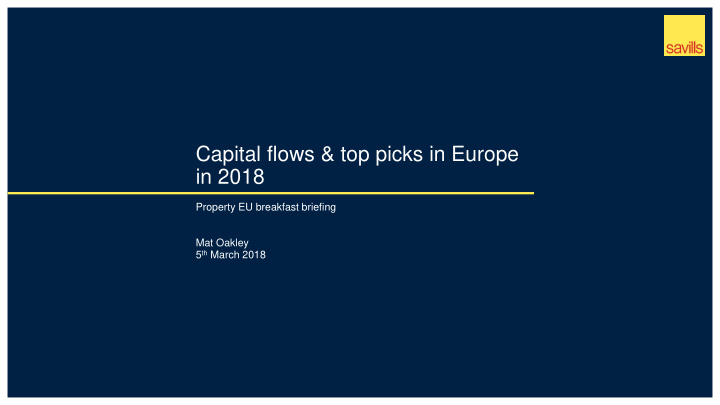



Capital flows & top picks in Europe in 2018 Property EU breakfast briefing Mat Oakley 5 th March 2018
The economic story is looking pretty solid Average annual GDP growth 2018-2022 4,0 3,5 3,0 2,5 %pa 2,0 1,5 1,0 0,5 0,0 Sources: Thomson Reuters, Focus Economics 2
Factors supporting further strong growth for the EU Upside: EU exports to China, 3 mth rolling average • Exports to China, new silk road and 16000 strong world trade • Consumer spending boosted by low oil 14000 prices 12000 • End of excessive austerity • Loose monetary policy 10000 • Easing of credit conditions €m 8000 Downside: 6000 • Brexit – negligible impact on anywhere other than the UK 4000 • Interest rates will come up & will affect 2000 weightings to real-estate • Low wage inflation could hamper 0 consumer economy 1-3-1999 1-1-2000 1-11-2000 1-9-2001 1-7-2002 1-5-2003 1-3-2004 1-1-2005 1-11-2005 1-9-2006 1-7-2007 1-5-2008 1-3-2009 1-1-2010 1-11-2010 1-9-2011 1-7-2012 1-5-2013 1-3-2014 1-1-2015 1-11-2015 1-9-2016 1-7-2017 3
European investment volumes were up by about 10% last year 300.000 2,5 Millions 2,0 250.000 1,5 200.000 GDP % pa 1,0 150.000 0,5 100.000 0,0 50.000 -0,5 0 -1,0 2012 2013 2014 2015 2016 2017 GDP Commercial investment volumes (€)
Activity driven by significant recovery in UK, NL and strong DE markets, with the UK being the dominant market Romania 0% Austria Annual change in Investment 2% Belgium Denmark 1% 140% Czech Republic 2% 1% 120% Finland 4% 100% 80% UK 60% France 29% 11% 40% 20% 0% Germany -20% 23% -40% Sweden 4% -60% Spain Ireland Luxembourg Sweden Norway Italy Portugal Denmark Czech Republic Poland Germany Spain Belgium France Romania Netherlands UK Greece Austria Finland Serbia 4% Portugal Greece 1% Ireland Netherlands 0% 1% 8% Italy Poland 3% 2% Norway 2%
With cross-border investors rising in importance, both from the USA and APAC 100% Source of Cross border capital in Europe - 2017 35.000 450% 90% Millions 400% 30.000 80% 350% 25.000 300% 70% 20.000 250% 200% 15.000 60% Other 150% 10.000 Private 50% 100% Prop Co 5.000 50% Institution 40% 0 0% Cross-border United States China United Kingdom France Germany Switzerland Hong Kong Singapore South Korea Canada 30% 20% 10% 2017 Vol (€) yoy change 0% 2014 2015 2016 2017 6
London remains the #1 destination for cross-border investment into Europe, primarily due to its attraction to APAC investors Hamburg +203% Milan +187% +118% Rhine-Ruhr Metro -41% Paris -4% Berlin Frankfurt +197% +2065% Helsinki +61% Amsterdam Metro +1257% Madrid London +2% € 0 € 2 € 4 € 6 € 8 € 10 € 12 € 14 € 16 € 18 Billions North America APAC Mid-East Other Source: RCA 7
Factors that I see affecting capital flows into real-estate and favoured destinations going forward • Chinese policy • Security & stability • Returns on other asset classes • Rising base rates/sovereign bond yields • Falling property yields • The cycle! • Structural challenges/changes to property • Retail, e-tail and distribution – will only one survive? • Wellness, what workers want, Workspace as a service (WaaS), AI and demand for office space 8
My top picks for 2018 9
Offices – expensive in the core, maybe time to look to the fringes • EU28 office-based employment grew by 2.5% in 2017 Investors are already pushing into fringe or future core • submarkets Average vacancy rate dropped 50bps in 2017 to 7.3% 2017 Volume Average • Development activity is picking up, but Grade A CBD undersupply will remain a theme Frankfurt: South • Rents to rise 2.5% to 5% in 2018 Prague: Outer City But • Frankfurt: Eschborn Yields are low and likely to go lower in the core • Development finance still limited Amsterdam: Hoofddorp • WaaS just beginning to challenge traditional landlords Dusseldorf: South in Europe Helsinki: CBD • Pick: edge of core and future core, TAMI friendly refurbs, turning secondary into prime Oslo: Bryn/Helsfyr Munich: Periphery South-East Hamburg: City South Extension Dusseldorf: Hilden €0,0B €0,5B €1,0B €1,5B Chart source: RCA 10
Retail – strong consumer story will be challenged by rise in online, but good locations will remain strong • Consumer confidence almost at record levels Retail warehousing prime rental • Private consumption growth to stabilise at around growth 1.5%pa 20% 20% 17% • Prime high street rents broadly stable 15% 13% • Mall rental growth polarising between good locations 10% 9% 6% 8% 10% and the rest 3% 5% • Shift to online will happen 164% 0% • Pick: Experience or Convenience, retail -5% -3% warehousing is the most internet-defensive -4% -10% segment -15% -14% -15% -20% Amsterdam Athens Brussels Copenhagen Dublin Helsinki London Madrid Oslo Paris Stockholm Vienna Warsaw yoy 5y growth 11
Logistics & industrial: The internet play • Industrial and office yield gap will close further (in the Prime warehousing rents up 2% last year, and 11% UK industrial is now yielding lower than offices) up on five years ago • Investment volumes up 60% on 2016 Offices Shopping Centres Industrial But 8,0% • Operator margins are slim and can easily be challenged by rising staff costs 7,0% • Investor competition will intensify • Autonomous vehicles will redraw distribution maps 6,0% • Picks: urban logistics for e-commerce, Benelux, CEE 5,0% 4,0% 3,0% 2,0% 10 Q2 10 Q4 11 Q2 11 Q4 12 Q2 12 Q4 13 Q2 13 Q4 14 Q2 14 Q4 15 Q2 15 Q4 16 Q2 16 Q4 17 Q2 17 Q4 12
The rest: lots of interest in “alternatives” and property plays driven by structural change Top 10 sectors for investment dictated more PRS/Resi Hotel Student Housing by fashion than liquidity? Seniors Housing Data Center Other 1. Logistics €100B 2. Seniors housing 3. PRS €80B 4. Self-storage 5. Student housing 6. Serviced offices €60B 7. Mainstream housing 8. Healthcare €40B 9. Data centres 10.Industrial/warehouse €20B €0B '07 '08 '09 '10 '11 '12 '13 '14 '15 '16 '17 Source: PWC Emerging Trends Europe 2018 (left), RCA (right) 13
Recommend
More recommend